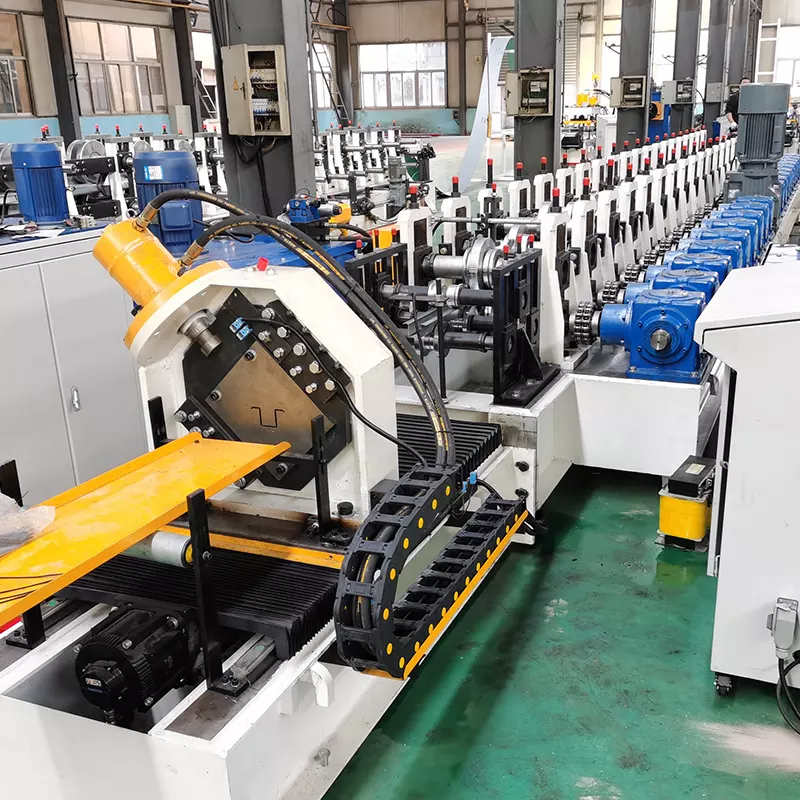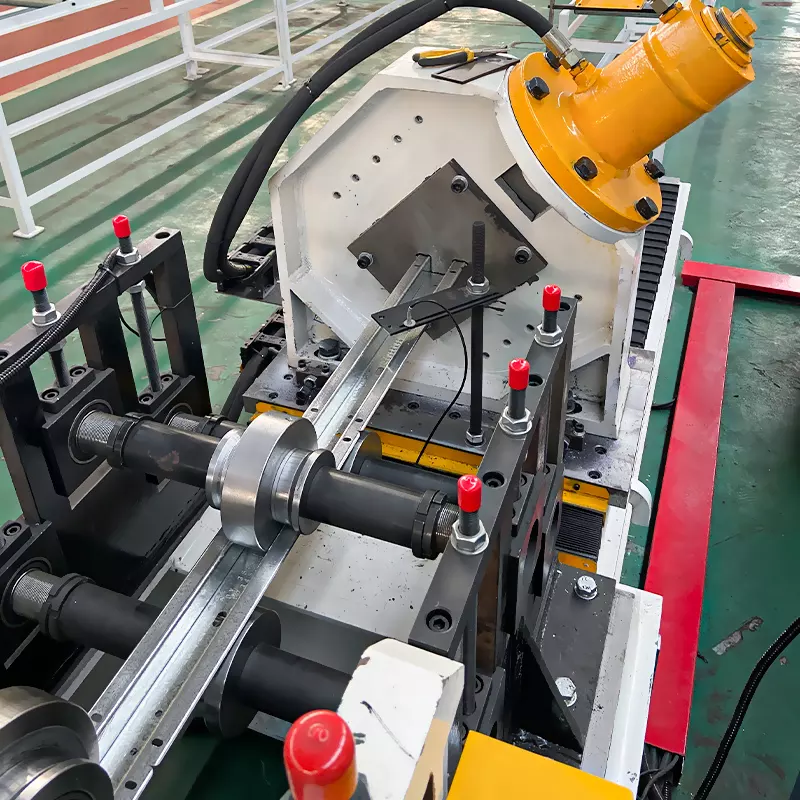Введение
The bending radius in roll forming plays a crucial role in determining profile accuracy, material integrity, and overall production efficiency. Selecting the right bending radius ensures optimal forming performance, minimal defects, and extended machine life.
But how do you calculate the correct bending radius for roll forming applications? Что такое best practices for adjusting machine settings based on bending radius?
В этом руководстве мы рассмотрим:
✅ How bending radius impacts roll forming
✅ Recommended bending radii for different metals
✅ How to adjust roll forming machines for different radii
✅ Common bending radius problems & solutions
✅ How to optimize roll forming for small and large bending radii
Давайте погрузимся в the critical role of bending radius in roll forming and how to optimize your production for maximum efficiency in 2025!
How Bending Radius Affects Roll Forming
1. Material Stress & Spring-Back
- Smaller bending radii generate higher stress, increasing the risk of cracking and material fatigue.
- Larger bending radii уменьшить spring-back effects, что приводит к better dimensional accuracy.
2. Machine Load & Roller Wear
- Tighter bends require greater force, что приводит к higher wear on dies and rollers.
- Gradual bends distribute stress evenly, extending machine life.
3. Profile Accuracy & Surface Finish
- Incorrect bending radii can cause deformations, что приводит к poor-quality profiles.
- Optimized bending angles ensure smooth material flow, уменьшая surface imperfections.
4. Speed & Energy Consumption
- Tighter bends require slower speeds to allow gradual material flow.
- Wider bends can be formed fasterоптимизация эффективность производства.
Совет профессионала: Correct bending radius selection can reduce forming defects by up to 30%!
Recommended Bending Radius for Different Metals
Different metals have unique bending properties, требуя specific bending radius ranges for optimal performance. Below is a comparison of recommended minimum bending radii for different metals.
| Тип материала | Recommended Minimum Bending Radius (Times Material Thickness) | Лучшие приложения |
|---|---|---|
| Мягкая сталь | 1.0 – 2.0× thickness | Structural components, roofing sheets |
| Нержавеющая сталь | 2.0 – 3.0× thickness | Автомобильная, аэрокосмическая промышленность, медицинское оборудование |
| Алюминий | 1.5 – 3.0× thickness | Lightweight structures, HVAC, enclosures |
| Оцинкованная сталь | 1.0 – 2.5× thickness | Corrosion-resistant frames, construction materials |
| Copper & Brass | 0.5 – 1.5× thickness | Electrical components, decorative trim |
Совет профессионала: Stainless steel requires larger bending radii due to its high spring-back effect!

How to Adjust Roll Forming Machines for Different Bending Radii
To ensure optimal roll forming performance, machines must be adjusted based on bending radius requirements. Ниже приведены key machine settings that must be optimized:
1. Roller Die Design & Setup
✅ Использование progressive forming passes to gradually achieve tight bends.
✅ Smaller bending radii require precision roller clearance предотвращать растрескивание материала.
2. Forming Pressure & Speed Control
✅ Higher forming pressure is needed for smaller radii, but too much pressure can cause cracking.
✅ Slower forming speeds help control material stress and spring-back.
3. Lubrication & Cooling Adjustments
✅ Tight bends generate more friction, требуя increased lubrication to prevent surface damage.
✅ Cooling systems help manage heat buildup, reducing the risk of material fatigue.
4. Material Pre-Treatment & Annealing
✅ Annealing softens metals, что позволяет smaller bending radii without cracking.
✅ Обработка поверхности уменьшить friction and wear on rollers.
Совет профессионала: Proper machine adjustments for bending radius can extend roller lifespan by 40%!
Common Roll Forming Bending Radius Issues & Solutions
Incorrect bending radius selection can lead to production defects, machine wear, and increased scrap rates. Ниже приведены common roll forming bending issues and their solutions.
| Проблема | Причина | Решение |
|---|---|---|
| Edge Cracking | Bending radius too small | Increase bending radius, anneal material |
| Excessive Spring-Back | High-strength material with tight radius | Adjust roller clearance, use over-bending techniques |
| Surface Wrinkling | Insufficient roller support | Increase forming passes, optimize roller shape |
| Distorted Profile Shape | Uneven bending force | Recalibrate rollers, ensure balanced forming pressure |
| Roller Wear & Indentations | High friction in tight bends | Apply proper lubrication, use hardened steel rollers |
Совет профессионала: 80% of bending defects are caused by incorrect machine adjustments—regular calibration is key!
Best Practices for Roll Forming Small & Large Bending Radii
Different strategies must be used when roll forming small and large bending radii на optimize forming accuracy and reduce defects.
Roll Forming Small Bending Radii (Tight Bends)
✅ Использование multiple forming passes to gradually achieve tight bends.
✅ Reduce forming speed to allow material to flow smoothly without cracking.
✅ Применить high-performance lubrication на minimize friction and surface wear.
Roll Forming Large Bending Radii (Wide Bends)
✅ Использование increased roller spacing to allow for gradual bending without over-compression.
✅ Increase forming speed улучшать эффективность производства.
✅ Использование опорные ролики to maintain profile consistency.
Совет профессионала: Tighter bends require more forming passes to distribute stress evenly!
Advanced Roll Forming Techniques for Achieving Precise Bending Radii
To achieve accurate and repeatable bending radii, manufacturers must employ advanced forming techniques that optimize material flow, reduce stress, and improve final product quality. Below are the most effective methods for controlling bending radius in roll forming.
1. Progressive Bending Passes for Tight Radii
- Gradual bending over multiple passes уменьшает stress concentrationминимизируя cracking risks.
- Обеспечивает smooth material flow, предотвращая surface defects and distortions.
- Идеально подходит для high-strength materials like stainless steel and titanium.
2. Over-Bending Compensation for Spring-Back Correction
- Spring-back is common in high-strength materials, требуя pre-calculated over-bending.
- Over-bending compensates for elastic recoveryобеспечивая final profile meets design specs.
- Essential for aluminum, stainless steel, and high-strength steel.
3. CNC-Controlled Roller Adjustment for Precision Bending
- Computer-controlled roller positioning allows for real-time bending radius adjustments.
- Уменьшает operator errorобеспечивая consistent forming accuracy.
- Лучшее для automotive and aerospace applications requiring tight tolerances.
Совет профессионала: Using CNC-controlled roller adjustments can improve bending accuracy by 40%!
How to Optimize Roll Forming Speed for Different Bending Radii
Выбор правильного forming speed имеет решающее значение для avoiding defects and ensuring material stability. Ниже представлено сравнение optimal forming speeds based on bending radius.
| Bending Radius | Recommended Forming Speed (m/min) | Key Adjustments |
|---|---|---|
| Tight Radius (1.0× Material Thickness) | 5 – 15 m/min | Slow forming speed, increased lubrication |
| Medium Radius (1.5× – 3.0× Thickness) | 10 – 30 m/min | Balanced speed, controlled forming pressure |
| Large Radius (3.0× Thickness and Above) | 20 – 50 m/min | High-speed forming, optimized roller spacing |
Совет профессионала: Tighter bends require slower forming speeds to prevent cracking and excessive stress buildup!
How to Reduce Material Waste When Roll Forming Different Bending Radii
Material waste increases production costs and reduces efficiency. Below are strategies to minimize scrap rates while maintaining bending accuracy.
1. Use Pre-Calibrated Roller Dies for Precise Bends
✅ Ensures repeatable accuracy, уменьшая trial-and-error adjustments.
✅ Prevents excessive material stretching that leads to waste.
2. Implement Smart Thickness & Radius Sensors
✅ Real-time monitoring of material thickness and bend angle предотвращает over-bending or under-bending.
✅ AI-driven systems can auto-correct roller pressureоптимизация waste reduction.
3. Optimize Coil Feed & Tension Control
✅ Maintaining consistent material flow предотвращает uneven bends and misalignment.
✅ Уменьшает material scrap due to incorrect bend formation.
Совет профессионала: AI-powered bending control can reduce material waste by up to 25%!
Common Roll Forming Bending Radius Challenges & Solutions
Handling different bending radii can pose various challenges. Ниже приведены common problems and their solutions.
| Проблема | Причина | Решение |
|---|---|---|
| Cracking in Tight Radii | Excessive forming force on brittle materials | Use gradual bending passes, anneal material |
| Excessive Spring-Back | High-strength material with tight radius | Adjust roller clearance, apply over-bending techniques |
| Distorted Profile Shape | Uneven roller force distribution | Optimize roller alignment, balance forming pressure |
| Roller Indentations on Surface | Excessive friction during forming | Apply proper lubrication, use hardened steel rollers |
| Edge Waviness | Incorrect material feed tension | Adjust coil tension, ensure smooth material flow |
Совет профессионала: 80% of forming defects are caused by incorrect machine adjustments—regular calibration is key!

Best Practices for Roll Forming Machines Handling Multiple Bending Radii
To efficiently process profiles with varying bending radii, follow these best practices:
1. Use Multi-Stage Roller Dies
✅ Allows gradual transition between tight and wide bends, уменьшая stress concentration.
✅ Prevents material cracking and spring-back inconsistencies.
2. Implement Quick-Change Tooling for Radius Adjustments
✅ Enables fast adjustments for different bending radii, improving гибкость производства.
✅ Уменьшает setup time, improving overall efficiency.
3. Invest in Adaptive Forming Technology
✅ AI-driven forming systems автоматически регулировать roller clearance, speed, and pressure.
✅ Ensures consistent profile accuracy across complex bending requirements.
4. Maintain Proper Lubrication & Cooling Control
✅ Tighter bends generate more heat, требуя advanced cooling systems.
✅ High-speed forming needs controlled lubrication предотвращать roller wear.
Совет профессионала: Adaptive forming technology can improve production speed by up to 30%!
FAQ: Roll Forming Bending Radius & Machine Optimization
1. What is the minimum bending radius for roll forming?
- The minimum bending radius depends on material type, but typically ranges from 1.0× to 3.0× material thickness.
2. How do I prevent cracking when forming small bending radii?
- Используйте annealed materials, increase forming passes, и apply proper lubrication.
3. How do I adjust my machine when switching to a larger bending radius?
- Increase roller spacing, adjust forming pressure, и optimize roller design.
4. Why does my roll-formed part have excessive spring-back?
- This occurs with high-strength materials. Use over-bending techniques и optimize roller pressure.
5. Where can I buy roll forming machines that support different bending radii?
Для валковые формовочные машины, изготовленные по индивидуальному заказу, посетите WUXI SUNWAY MACHINERY CO., LTD..
Заключительные размышления
Выбор правильного bending radius важно для high-precision, defect-free roll forming. By optimizing machine settings, using proper lubrication, and adjusting forming passesпроизводители могут reduce defects, improve production efficiency, and extend machine life.
WUXI SUNWAY MACHINERY CO., LTD. это ведущий мировой производитель из валковые формовочные машины, изготовленные по индивидуальному заказу, предлагая Передовые технологии, экспертная поддержка и конкурентоспособные цены.
Want to optimize your roll forming bending radius? Свяжитесь с нами сегодня!
